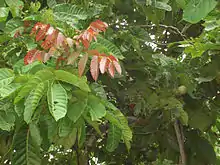| Pometia pinnata | |
|---|---|
 | |
| In flower, Tonga | |
 | |
| New growth and developing fruit | |
| Scientific classification | |
| Kingdom: | Plantae |
| Clade: | Tracheophytes |
| Clade: | Angiosperms |
| Clade: | Eudicots |
| Clade: | Rosids |
| Order: | Sapindales |
| Family: | Sapindaceae |
| Genus: | Pometia |
| Species: | P. pinnata |
| Binomial name | |
| Pometia pinnata | |
Pometia pinnata is a large tropical hardwood and fruit tree species, with common names including matoa, taun tree, island lychee, tava,[1] Pacific lychee of the plant family Sapindaceae.[2]
Naturally widespread, the trees are native to tropical South Asia, Southeast Asia, and Melanesia. It was transported during the Austronesian expansion to Polynesia during prehistoric times,[2][3] evident by cognates of local names used on islands ranging from Sulawesi to Niue.[1]
Description
Pometia pinnata grows into medium tree of 40 m (130 ft) tall.[2] It has pinnate leaves. The fruits are green, yellow, or dark red up to 4 cm (1.6 in) long, each with one seed surrounded by a fleshy aril.
This popular fruit is slightly larger than a longan, but its flesh is less watery and its shell is thicker.
References
- 1 2 Blust, Robert; Trussel, Stephen (2010). "*tawan kind of fruit tree: Pometia pinnata". Austronesian Comparative Dictionary. Max Planck Institute for Evolutionary Anthropology. Retrieved 8 November 2022.
- 1 2 3 Conn, Barry J.; Damas, Kipiro Q. (2006). "PNGTreesKey" (Online, from pngplants.org/PNGtrees/TreeDescriptions/). Guide to Trees of Papua New Guinea. Retrieved 16 Nov 2013.
- ↑ Blench, Roger (2008). "A History of Fruits in the Southeast Asian Mainland". In Osada, Toshiki; Uesugi, Akinori (eds.). Occasional Paper 4: Linguistics, Archaeology and the Human Past. Indus Project, Research Institute for Humanity and Nature. pp. 115–137.